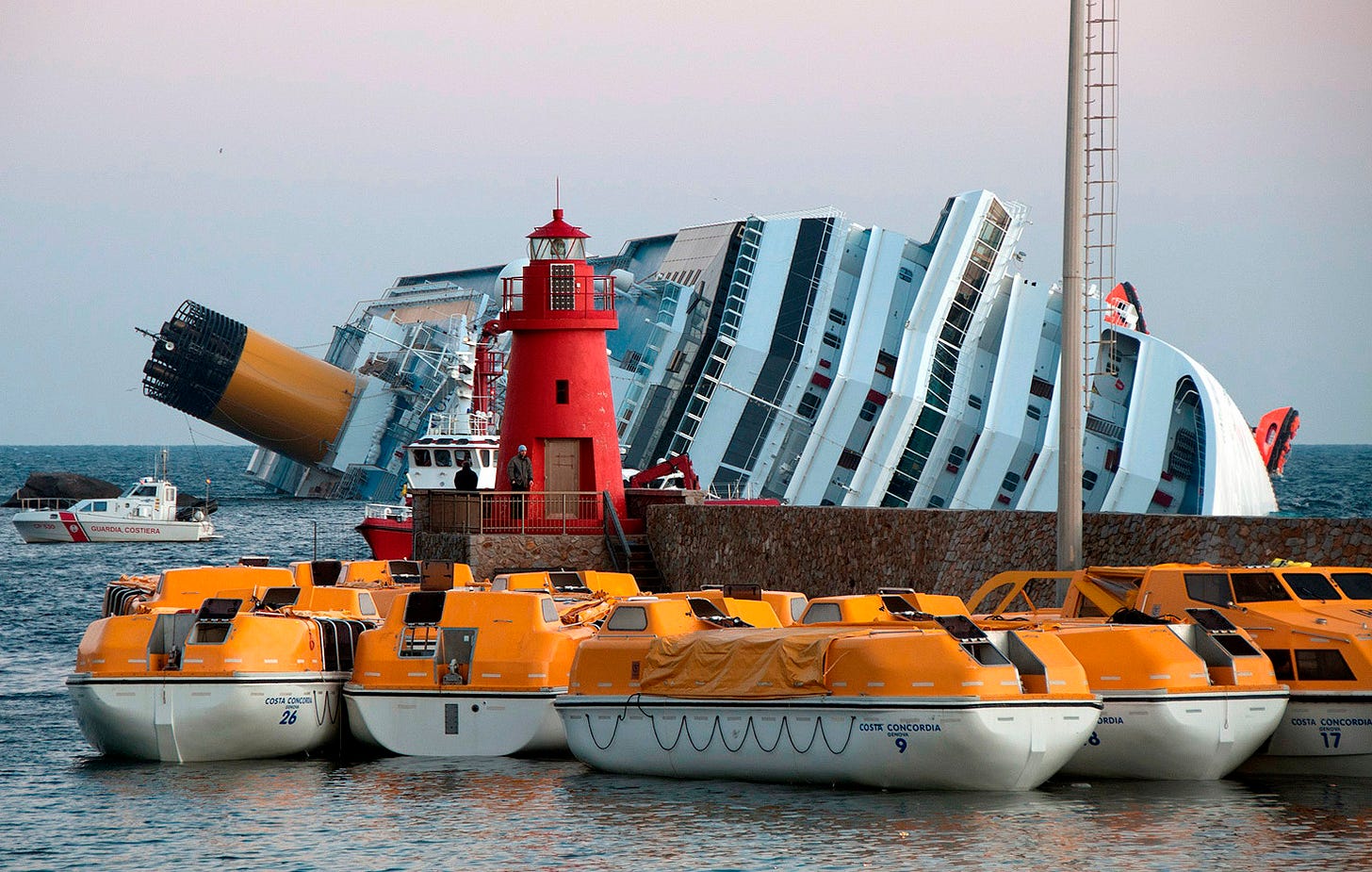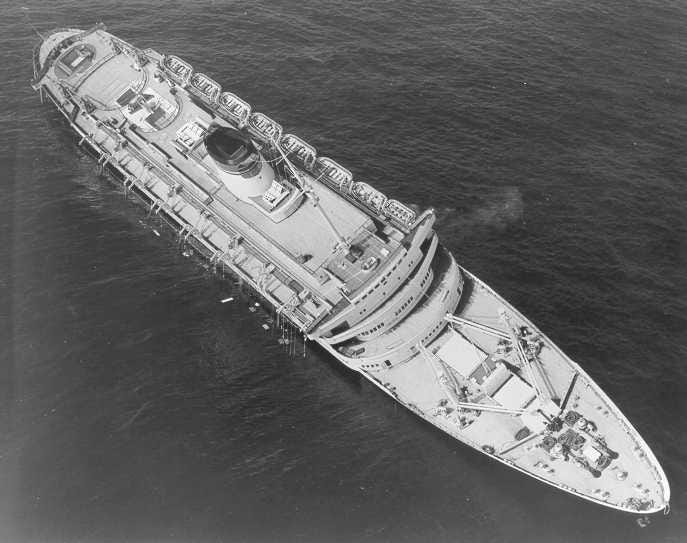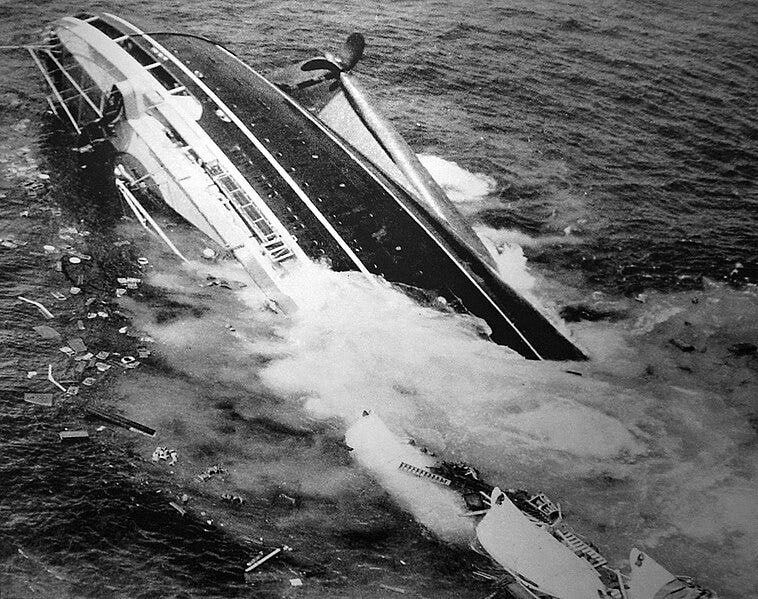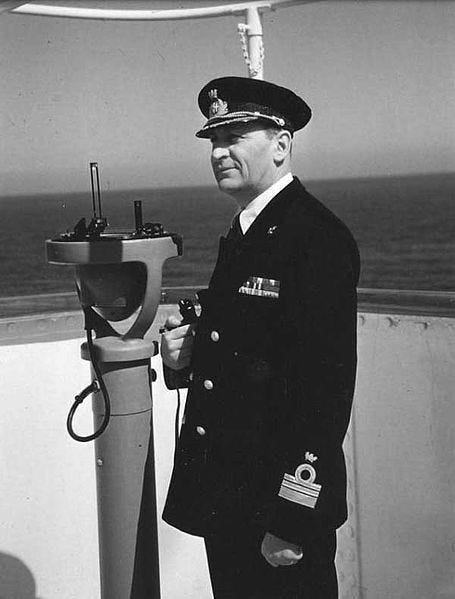A Tale of Two Captains
How the actions of one led to disaster, and actions of another saved lives
On the 13th of January 2012, the seven-year-old cruise ship Costa Concordia, carrying 4252 passengers and crew, was on the first part of it's journey around the Mediterranean Sea. That evening on it's way to the Isola del Giglio, Tuscany, the captain decided to deviate from the route to perform an unplanned sail-by salute on the nearby island.
As they approached the island, the captain turned off the ship's alarm on the navigation system. He felt confident as he had sailed there several times before. "I was navigating by sight, because I knew those seabeds well,'' he rationalized.
The ship crept closer and closer to the island. Around 22:00 PM, it was a mere 300 meters from shore.
All of a sudden, a thundering bang resonated throughout the ship. Everything shook violently, sending dishes crashing on the floor. In a panic people started running, and unable to keep their balance, were falling down the stairs. When things seemed like they couldn't get worse, the entire ship suddenly began tilting to the left. It was like a scene from the movie Titanic.
The Costa Concordia had just violently struck a rock formation on the sea floor, causing a 36.5m (120ft) tear in it's hull. The ship was now slowly sinking. Within a few minutes the generators and engines were submerged, leading to widespread electrical failure.
Despite the severity of the situation, port authorities were only notified an hour later, and the order to evacuate was given after that. A mere 40 minutes later, the ship's captain, Francesco Schettino, fled on a lifeboat, leaving 300 passengers onboard to fend for themselves.
Tragically, 27 passengers and 5 crew members lost their lives.

''Captain Coward''
Many things went wrong during that fateful evening, but ultimately it was the failure of the captain that turned a terrible situation into a tragedy. His actions, before, during and after the incident are unfortunate examples of how a leader should not act in pressing circumstances. It's also a warning of how a single person's behaviour and decisions can have such a strong impact on the outcome of a situation.
Costa Concordia's journey began from the port of Civitavecchia, Italy, at 19:20, where 3,206 passengers boarded. Among those were 600 passengers (almost 20%) who did not receive the mandatory lifeboat evacuation drill, as they had embarked just hours before departure.
During the next two hours, guests settled into their cabins and gathered at the dinning hall to enjoy the first dinner of their seven-day cruise. They were blissfully unaware that at 21:10, their captain had decided to deviate from the planned route (possibly to impress a dancer with whom he was having an affair), and turned off the alarms due to overconfidence in himself. Despite choosing to ''navigate by sight'', Schettino had left his glasses in his cabin, having to repeatedly ask the ship's first officer, Ciro Ambrosio, to check the radar for him.
Schettino did have previous experience performing a sail-past salute on the Island, and a year earlier the ship had been approved to do so. However, it was during daylight and they passed 8 km (5mi) from shore.

This time however it was late at night with less than ideal visibility, with the captain distracted and a mere 300 meters (980 ft) from shore, disaster was inevitable. So at 21:42, the ship struck the reef, leading to widespread panic. Despite the monstrous shake, loss of lights and the ground slowly tiling to one side, passengers were told everything was ok and under control. Some crew members went as far as announcing that ''we have solved the problems we had and invite everyone to return to their cabins."
Passengers were terrified and the crew were dazed. It took a half hour for the first contact to be made, where at 22:12 an officer informed the port that their only issue was from an electrical black-out due to problems with the electrical generator. Minutes later at 22:20, a patrol boat tried to reach the Costa Concordia but no one answered. All the while, Schettino had made several calls with the cruise line's crisis management officer.
Only at 22:42, a full hour after the initial impact that the port authorities are informed of the gravity of the situation. Finally at 22:50, after 8 agonizingly long minutes, the order for evacuation was announced. However, things only continued to get worse. Some crew members resisted lowering the lifeboats, making passengers wait up to 45 minutes, leading some people to jump off the ship in an attempt to swim to shore.
At 23:30, by the time those same passengers were finally able to board the lifeboats, Schettino was already safely escaping. He claimed to have accidentally fallen into a lifeboat. While on his way to safety, the Coast Guard captain, Gregorio de Falco, urged him to go back to his ship. But stalling and excuses from Schettino infuriated him, causing him to snap and yell "Vada a bordo, cazzo!'' ("Get the fuck [back] on board!"). Schettino claimed that it was too dark and he couldn't go back. These calls went back and forth until 01:46.
Schettino never returned to the ship, and was one of the first people to reach land.
Soon after a Giglio police officer found him and offered a boat to get him back, but Schettino declined. The officer noted that Schettino was dry, despite claiming to have fallen off the ship. Later, Schettino found a nearby hotel where he hid.
It should be noted that despite Schettino's failures, many crew members stepped up to do the right thing. In a case of mutiny, long before the evacuation was ordered, they were already lowering lifeboats and leading passengers out of their cabins.
Unlike the captain, they stayed until the end.
The Captain Goes Down with the Ship
On the morning of 17th of July 1956, the SS Andrea Doria set out on a typical crossing of the North Atlantic. Starting it's journey in Genoa Italy, it was headed to it's final destination in New York. The ship was booked to 90% of it's capacity, with a total of 1706 passengers and crew.
Eight days later, on Wednesday 25th of July, the Swedish passenger liner Stockholm departed from New York Harbour to cross the Atlantic, headed to her home port of Gothenburg in Sweden. The ship was booked mostly to capacity, with 534 passengers and crew. In order to save time, the Stockholm changed it's course placing it directly in the path of westward traffic coming towards New York.
As the cold Labrador Current encounters the warmer Gulf Stream, the waters around the North Atlantic tend to become frequently foggy. Both ships were travelling in dense fog and had taken the necessary precautions, but being aware of each other's presence only through radar.
Both ships were sailing at a combined speed of 74km/h (46mph), when all of a sudden, an Andrea Doria officer shouted, ''She’s coming right at us!''. By then it was too late, they were approaching each other head on. At 21:10, the ships collided.
They had misinterpreted each other's course on their radars.
The massive 12'165 ton, 120m, Stockholm rammed into the hull of the Andrea Doria, leaving a gaping hole in the side of the ship. Passengers abroad the Andrea Doria were thrown around from an incredible shake, and heard the deafening sound of metal shearing. The Andrea Doria immediately started taking on water and begun leaning heavily on it's side, so much so that half the lifeboats were unusable.
Despite the ensuing chaos and panic, remarkably all 1660 passengers and crew that survived the initial impact were successfully recused. The accident took the lives of 51 people (46 Andrea Doria, 5 Stockholm), who died directly due to the collision.
Both the sinking of the Andrea Doria and the Costa Concordia were tragic events. But despite similar circumstances, the Andrea Doria managed to save it's passengers and crew. What happened differently that led to a successful response to the emergency?

Immediately after the collision, the Andrea Doria sent an SOS call.
SOS DE ICEH [this is Andrea Doria] SOS HERE AT 0320 GMT LAT. 40.30 N 69.53 W NEED IMMEDIATE ASSISTANCE
Within minutes, the ship leaned an extraordinary 20° and the captain, Piero Calamai, realized that the ship was doomed. ''Resigning himself as best he could … to the loss of his ship, Captain Calamai turned to saving the passengers.''1
One of the officers on deck asked permission to sound the abandon-ship alarm, but Captain Calamai hesitated. Due to the severe leaning of the ship, half of the lifeboats were too high in the air, making them unlaunchable. On the other side of the ship, the lifeboats were too close to the water, launching them would be additionally complicated. He understood that once passengers discovered that there weren't enough lifeboats, the ensuing panic would cause more danger for everyone. Calamai decided not to not give out the order to abandon ship until help arrived.
Meanwhile, a loudspeaker announcement instructed passengers to put on lifebelts and head to the emergency stations.
Aware of the gravity of their situation, the Andrea Doria radioed:
''Here danger immediate. Need lifeboats—as many as possible—can’t use our lifeboats.''
Then, the decision to abandon ship was made. A mere 30 minutes after the impact.
Although the Stockholm was badly mangled, it was floating steadily and mostly safe. They began rescuing passengers from the Doria. Luckily the accident took place in a heavily travelled part of the Atlantic, and thus several vessels heard the Doria's distress calls and raced to the rescue. The first ship, a small freighter called the Cape Ann arrived at 00:30 am, followed by two American Navy ships, but they had few lifeboats between them. It was not until 02:00 am that the massive French ocean-liner SS Île de France arrived, positioning itself next to the Doria, lighting up the darkness with its floodlights and making rescue possible with its lifeboats.
As the rescue operations took effect, Calamai did his best to supervise the situation, keeping his crew organized and prioritizing the safety of his passengers. “Above all, he struggled to maintain the calm deliberateness that had marked his career, determined to set the mood for his fellow officers and crew”1. However, some of the crew did not follow Calamai's example and rushed to the lifeboats. Not knowing how things would turn out and if he'd get another chance, Calamai told one of his officers, ''If you are saved, maybe you can reach Genoa and see my family. Tell them I did everything I could.''
It was only after when the evacuation was complete that Calamai turned his attention to his ship. He deliberated whether his ship could be towed to shallower water. But it was clear it would be impossible.
After a long night of arduous work, and making sure all the survivors had been properly evacuated to the rescue ships, only then did the remaining crew on the Doria begin to abandon ship. Captain Calamai was determined to go down with his ship, in order to take responsibility and atone for the disaster, but his crew refused to leave him behind. His officers conceived him to change his mind, and so at 06:00, Calamai reluctantly boarded the last lifeboat.
He made sure he was the last person off the ship.
By 09:45 the ship began to sink, and was under the ocean by 10:09.

A Coward and a Hero
Both are similar stories of tragedies, but with completely different reactions by their captains. It comes to show that the actions of one can lead to disaster, and actions of another can save lives.
Captain Francesco Schettino's case
Schettino failed as a captain and leader, before, during and after the events of the Costa Concordia sinking.
Firstly, it was his responsibility to make sure everyone on his ship has received adequate preparation in case of an emergency.
It's also unclear whether anyone on the bridge confronted Schettino on changing the route or turning off the alarm, but given the hierarchical culture of the naval industry, decisions from superiors are often gone unchallenged. An environment of rigid hierarchy is apparent as officers were afraid of contacting authorities, and downplaying the situation when they finally did. When an organization lacks trust, people's reactions are to try and ''fix'' problems by keeping them hidden.
A leader's role is to create an environment where subordinates can challenge their superiors, point out mistakes and not be punished for doing so. This was clearly not the case abroad the Costa Concordia.
Moreover, there was a lack of coordinated effort from the crew and officers, mostly because no one was in charge. A leader does not need need to micromanage everything, but they need to have everyone aligned. Are we abandoning-ship or not? Should passengers go to their cabins or wait at the emergency meeting points? When the objectives aren't clear and there's no communication, everyone has to scramble to figure out what to do, leading to additional chaos. It's the captain's responsibility to keep the crew organized and to have a clear mission.
Finally, a good leader puts others first before thinking of themselves. Schettino made the cardinal leadership mistake of trying to save his own skin first, before making sure everyone else was safe. This was an irredeemable action on his part.
Investigations began after the incident, leading Schettino to be placed under house arrest. The Italian media dubbed Schettino ''Captain Coward'', angering him, to which he retorted ''I'm a gentleman, not a coward''. In the years leading up to his trial, Schettino wrote and published the book Le verità sommerse (The submerged truths). The book was heavily criticized for trying to profit from the disaster, as well as an attempt by Schettino to improve his own image.
On 11th of February 2015, Francesco Schettino was sentenced to 16 years in prison, for manslaughter, causing the shipwreck, and abandoning his passengers.
Captain Piero Calamai's case
The Andrea Doreia's problems were not over after the accident, as litigation followed. Although it was agreed that the fog was the main culprit, nonetheless the Andrea Doria was found mainly culpable in the eyes of many. The Doria had not followed all the proper radar procedures, did not follow the rule that vessels approaching head-to-head should both turn right (Doria turned left to avoid a collision), and was sailing too fast for the foggy conditions.
Captain Calami didn't do everything perfectly. However, what's important is that he did his best during the emergency. Despite knowing that the accident was likely his fault, he did not fold under the pressure. His immediate priority was the safety of his passengers and crew. He did not let his human instinct of self-preservation get in the way of doing his duty.
He and his team quickly reached out for help, and worked together in a mostly coordinated way to aid in the rescue operations. These actions played a pivotal role in the successful rescue of all the surviving passengers.
In the end, no definitive cause for the accident was ever found, as an out of court settlement was reached.
After the Andea Doria incident, Piero Calamai retired and never accepted to command another ship. According to his daughter, he lived the rest of his life in sadness "as a man who has lost a son". He would go on to tell one of his friends that, "Before I used to love the sea. Now I hate it."
A month before Calamai's death, John C. Carrothers, a retired US naval engineer who had become a leading expert on naval collisions, wrote him a letter. He expressed his warm solidarity for the events that Calamai endured, and after 12 years was able to prove that the Stockholm had indeed been responsible. Carrothers ended the letter by stating, ''Rest assured Captain Calamai, there are many of us who would be more than willing to serve under your command at anytime". Unfortunately, Calamai would not get a chance to read the letter.
He died on April 7, 1972, at the age of 74, in his hometown of Genoa, Italy.
His last words were "Are all passengers safe?"

Making Your Actions Count
Very few people are the captains of ships. Even fewer people are the ones who end up being in charge during a disaster. However, there are still plenty of lessons we can learn from the stories of the Costa Concordia and Andrea Doria.
Mainly, about how to be a better person and leader.
When things get tough, there are two ways you can act. You can fold and only think about yourself. Or you can step up, regardless of your position or situation, and do the right thing.
The thing is, you don't have to be the one in charge to have a strong impact during a challenging situation. Helping others and putting them first (rather than worrying about yourself) makes you a leader by default.
The choice can be difficult and terrifying.
But by doing what's right, you will inspire others to do the same.
Post Script
During both the events of Costa Concordia and Andrea Doria, countless people's actions and efforts led to the successful rescue of the vast majority of passengers. Ships that were first on scene, emergency responders and rescue divers are to thank for the thousands of lives saved.
Another remarkable story needs to be highlighted about the actions of a captain, Raoul de Beaudéan. Prioritizing the lives of people instead of profits for his company was one of the reasons why all 1660 passengers were safely rescued.
You can read a more detailed account of his story in my mini article, Putting People Before Profits.
Footnotes
1. As described by Alvin Moscow in his book about the collision of the Andrea Doria and the Stockholm, Collision Course.
The retelling of the events of Andrea Doria by the survivor Pierette Domenica Simpson, who was 9 years old and travelling to America for the first time. The Night I Survived the Andrea Doria Shipwreck.
A full account of the events on July 25 1956. The Sinking of Andrea Doria.
An account of Captain Calamai's actions in response to the emergency. In Andrea Doria wreck, a captain who shone.
Thanks very much for reading!
If you have any feedback, ideas, suggestions, things I can improve, anything at all, please let me know!
Heck, if there’s something I can help you with, I’ll try my best!
Leave a comment below, reply to my notes, join the subscriber chat, reach out on Reddit or Bluesky, or send an E-mail!
I’m always happy to keep in touch :)
Please share this article if you enjoyed reading it!
And if you want to read more articles every week, you can subscribe here:
See ya next time!
Matthieu




